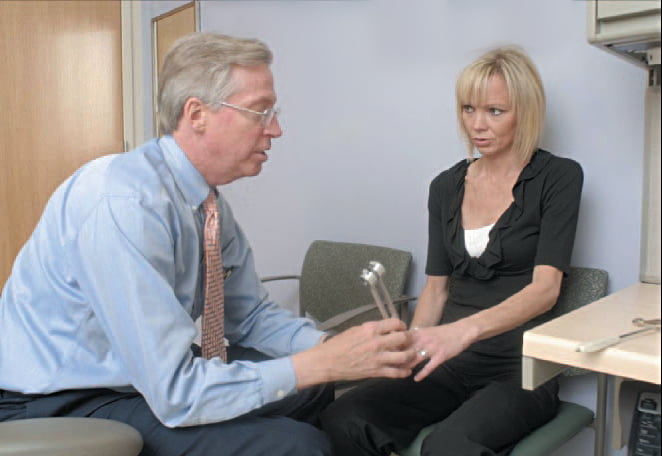
Over the last thirty years, we’ve refined our understanding of MS. With each research study, another dot is added to our picture of the disease. It’s certainly not a straight line and it’s often messy and full of frustratingly slow twists and turns. But even those twists and turns can add to our collective bank of knowledge. And this ever-evolving understanding gives us a foundation for significant hope and optimism for the future of MS treatment and research.
To learn more about what’s on the horizon for MS research, we spoke with Dr. John Corboy, Co-Director of the Rocky Mountain MS Center at University of Colorado.
InforMS: What are the big remaining questions in the world of MS?
Dr. Corboy: The really big questions? What’s the cause? What’s the cure? One of the other big questions that patients have and that we aren’t yet able to answer is: “What’s going to happen to me?”
To answer that question, we need a better way to separate the individuals with a relatively good prognosis from those with a relatively poor one. If we had that ability, we could do two things. First, we could identify those patients who don’t need to be treated at all, or who could be treated with any of the therapies, and those patients with severe disease who we need to treat aggressively, upfront. Second, being able to better define patients’ trajectory would allow us to do what we really want to do, which is treat to a target. In MS, we need a better way to define our therapeutic goal and tell if we have achieved it.
InforMS: What exactly are we trying to measure and how could a marker help us measure it?
Dr. Corboy: We are trying to measure neuronal—grey matter—damage, because that type of nervous system damage is the most strongly associated with disability.
“We could eventually use neurofilament blood markers to give us predictive information about how severe someone’s MS is.”
We know that if you damage a muscle such as your heart, you can see an increase in particular muscle proteins in blood – this marker is used as the basis of heart attack tests. Something similar happens in the brain. Neurofilament is a component of nerve cells. When a nerve cell is damaged it leaks, and you can identify the level of damage by measuring neurofilaments. It’s been known for years that you could measure neurofilaments in the spinal fluid. However, we have never incorporated this approach at the clinical level, because it is just not practical to perform repeated spinal taps in people. However, it was recently discovered that you could also measure neurofilaments in blood. The presence of neurofilament suggests that nerve cell damage is occurring. Hopefully we could eventually use neurofilament blood markers to give us predictive information about how severe someone’s MS is and to point us toward the best therapeutic approach.
Ultimately, the goal would be to use neurofilaments as response markers. We could measure whether or not the neurofilaments levels in your blood go back to normal levels if you’re treated with Drug X or Drug Y. That would tell us that nerve cell damage has slowed or been stopped, and would suggest that the drug is effective.
InforMS: I hear from patients all of the time that they feel like their MS is getting worse, but their neurologist tells them their MRI is fine. So it sounds like what you’re saying is there is a lot happening behind the scenes that our current tests or measurements can’t tell us?
Dr. Corboy: It is very important to convey that brain damage starts happening very early in MS. It simply isn’t the case that everyone is fine until they acquire disabling symptoms and develop progressive MS when they’re fifty. Brain damage and neuronal damage happen extremely early. The more evidence we have of this early, irreversible damage, the more we can stress that we have to treat patients differently. Not only do we have to try to address MS earlier and more aggressively, but also perhaps in completely different ways.
So, these sensitive biomarkers that show early nerve damage and brain atrophy, combined with volumetric MRIs, could allow us to powerfully reinforce the case for early and aggressive treatment.
InforMS: How do we know that this nerve damage is occurring early on in MS?
Dr. Corboy: There are people who get an MRI scan for other reasons and yet the MRIs look like MS. This is known as radiologically isolated syndrome. When you compare these patients to sex and age matched controls, they already have brain atrophy or brain volume loss, and yet they have not had a single clinical symptom. This means that the nerve damage was already happening before they had any clinical signs of MS.
There are also some fascinating studies of people who are newly diagnosed, that go back and look at what happened to them before they were diagnosed. One study examined whether or not low exercise levels led to a diagnosis of MS. They concluded that, no, it did not. But very interestingly, several years before the patients were diagnosed with MS, before they had symptoms, their exercise levels went down compared with age matched controls. So that tells us that something was already happening before they got diagnosed.
InforMS: What are some significant hindrances to progress in treating MS effectively?
Dr. Corboy: As a community, we still underestimate the significance of this disease. Everybody can see a heart attack – that is clearly severe. Cancer—that is clearly severe. But somehow, MS doesn’t count as severe for many people. Look at what is called “benign MS” by many: the definition of benign MS includes an Expanded Disability Status Scale (EDSS) of 3 at 10 years. That means moderate disability in one functional scale and mild disability in 3 to 4 functional scales, though still fully ambulatory.
What does that mean in practical terms? It may mean you’re not hiking; or you’re not doing 14ers; you may still be skiing, but probably not. You might not be working and you’re probably a little disorganized with your kids. And my question is: When did that become benign, and when did that become acceptable? We need to acknowledge that everyone has aggressive disease until proven otherwise. We are not able to make that distinction as well as we would like. And, of course, untreated or undertreated, many MS patients will develop disability.
InforMS: What other research is in the pipeline that gives you hope for the future?
Dr. Corboy: There is encouraging research on how to protect nerves from damage. It is important to alter or suppress the immune system—which is what DMTs do—but protecting against nerve damage is likely the key to preventing disability. We are looking at why cells die over time. One argument is that disruption in the energy mechanisms is what leads to cell damage and cell death over time.
“It is hypothesized that biotin may help slow, stop, or even reverse the progression of disability associated with demyelination.”
Some of our research is focused on compounds that may be neuroprotective. Biotin is a water-soluble B vitamin that is critical in energy metabolism and production of fatty acids. It is hypothesized that biotin may help slow, stop, or even reverse the progression of disability associated with demyelination. Studies have shown some progressive MS patients improving with high dose Biotin. To further explore this, there is going to be a large 400 person study over the next 27 months.
Research in this area is very preliminary and all the studies have been very small. How these sorts of drugs might be helpful and how they might be used—perhaps as add-on therapies to improve the effects of disease modifying drugs—is unknown. But they are causing excitement because they provide indications that neuroprotective strategies are a real possibility for people with MS.
InforMS: What about the repair or remyelination of nerve cells that have already been damaged?
Dr. Corboy: Strategies to repair the nervous system are in their infancy. The human body, including the central nervous system, has a tremendous capacity to replace damaged cells and to repair itself. We heal from cuts, we (at least some of us) grow new hair when the old falls out, and we mend broken bones.
The brain can also repair damage, and routinely does so in MS. Oligodendrocytes are myelin-making cells and they repair MS damage all the time. This is one reason people have remissions after a relapse—because the brain has repaired the problem. LINGO-1 is a protein that inhibits the development of myelin-making cells, which, in turn, limits the natural ability of the brain to remyelinate damaged axons. Anti-LINGO-1 blocks LINGO-1, and by so doing may stimulate myelin growth. Phase II studies of this molecule in 82 people with a first attack of optic neuritis found a small but statistically significant improvement in the speed of nerve conduction in the optic nerve, which suggest that there was possibly remyelination of the optic nerve. There was no improvement in visual function however.
InforMS: What are your thoughts on stem cell research for MS?
Dr. Corboy: The area of stem cell research to treat diseases, including MS, is huge. The basic problem in MS is that the immune system is attacking the nervous system. One strategy to fix this would be to get rid of the old, poorly behaving immune cells and replace them — or reboot — with cells that have not been programmed to attack the nervous system. The most publicized stem cell approaches in MS reboot the immune system.
There are lots of different types of stem cells, and they have different qualities and characteristics. They have different abilities to enter the nervous system and to migrate to where you need them to go. They might have different abilities, either to replace cells that are damaged or to stimulate those cells that are already in the nervous system, or help them to function better.
Unfortunately, stem cells that are injected into a person’s body are not likely to enter the nervous system and induce repair. None of the stem cell studies have suggested that you would be able to regrow nerves. If you are going to do something to repair nerves, you will need preprogrammed cells that can go down the correct developmental path to become nerve cells, and then somehow get to the appropriate place where they can set up shop, create new connections, and stop reproducing.
It is important to recognize that these types of treatments are not approved for use in the United States. Recently the New England Journal of Medicine published a paper about an MS patient who went to three different stem cell clinics outside of the United States. The patient’s spinal fluid was injected with mesenchymal embryonic fetal neural stem cells. He later developed multiple complications including paraplegia with urinary incontinence. This is a cautionary tale for patients who are interested in stem cell research. Going somewhere and getting something randomly shot into your body is extremely risky.
Although it’s a cautionary tale, that doesn’t diminish the interest in stem cell research, but it’s all very preliminary and there is a lot that we just don’t know.
InforMS: Are you hopeful about the future of MS treatment and research?
Dr. Corboy: Yes, I am very hopeful. The key is to change our collective mindset. We have some really good treatments and wellness approaches for MS right now. The problem is that, as a community, we are not always using them. We know a whole lot about this disease and we have a lot of ways to treat it. One of the most important things we can do is change how we think about this disease – it’s an aggressive disease that must be treated early and in the most effective way possible.


